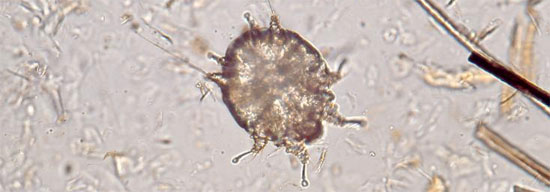Spread which is mainly confined to pig to pig contact and the infected pigs’ environment
Almost all infections commonly spread in this way but most also spread in other ways as well. Two prominent examples which tend to spread almost entirely in this way are sarcoptic mange and swine dysentery. A minor example is the pig louse, Haematopinus suis.

Sarcoptes scabei
Sarcoptes scabei mites can only lay eggs in the skin but the mites and their spores can survive in the environment for short periods. They are not likely to be spread from farm to farm by lorries or people if minimal precautions are taken. Farm to farm spread of swine dysentery requires infected pig movement or the movement of relatively large doses of infective faeces. In practical pig farming conditions H. suis can only be spread by pig to pig contact. It is readily eradicated from herds (thus eliminating swine pox too) and lice-free herds can be kept permanently free by the most basic biosecurity. Its reappearance in a previously free herd is a sure indication of a major break in biosecurity. Thus, even in locations of high pig density, diseases such as these can be reliably excluded by simple precautions.
Spread by fomites on people, animals and vehicles
Pathogens which are highly infectious and only require small doses to establish infection in susceptible pigs and/or those which are able to survive environmentally for relatively long periods can be spread from farm to farm as fomites.
Many viruses are highly infectious but they generally require special circumstances such as high humidity, cold weather and no exposure to sunshine, to survive outside the body. Ultraviolet light and dry warm conditions rapidly inactivate them. Examples are the viruses causing classical and African swine fever, transmissible gastroenteritis and porcine epidemic diarrhoea. These are not normally airborne so that standard biosecurity precautions should be effective in excluding them from herds in reasonably isolated locations. Such precautions are routine cleaning and disinfection of pig lorries, well designed and properly operated loading and unloading facilities, control over sources of bedding, feed and equipment, restriction of visitors and down-time between herd visits, showers and changes of clothing, and rodent control.

Cleaning and disinfection of pig lorries
Bacteria and parasites tend to survive much longer in the environment than viruses but generally require bigger infectious doses to cause disease. Common examples are Erysipelothrix insidiosa, some clostridia, most salmonellae and coliform bacteria. These are generally carried subclinically by pigs so the above biosecurity measures alone will not completely exclude them. Many high heath status herds are free from specific sub-clinical infections such as Actinobacillus pleuropneumoniae and Salmonella choleraesuis so pigs introduced from such herds should not bring these infections with them. However, such bacteria can be introduced as fomites.
A. pleropneumoniae can probably be carried from farm to farm in nasal secretions on clothing since the organism is plentiful the noses of affected pigs. Similarly, the nasal secretions of pigs with streptoccal meningitis are teeming with streptococci.
A. pleuropneumoniae has only been shown to be carried a few metres, field evidence strongly suggests that it may be windborne between neighbouring farms. S.suis can also be spread from farm to farm by flies. Windborne spread and spread by intermediate hosts will be the subject of the next article in this series.




